| Listing 1 - 10 of 15 | << page >> |
Sort by
|
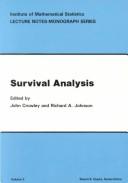
ISBN: 0940600021 Year: 1982 Volume: v. 2 Publisher: Hayward Institute of Mathematical Statistics
Abstract | Keywords | Export | Availability | Bookmark
 Loading...
Loading...Choose an application
- Reference Manager
- EndNote
- RefWorks (Direct export to RefWorks)
Failure time data analysis. --- Failure time data analysis --- Survival analysis (Biometry) --- Mathematics --- Physical Sciences & Mathematics --- Mathematical Statistics --- Analysis, Failure time data --- Data analysis, Failure time --- Failure analysis (Engineering) --- Mathematical statistics --- Competing risks --- Analysis, Survival (Biometry) --- Survivorship analysis (Biometry) --- Biometry --- Congresses

ISBN: 0792337832 1441947531 1475756542 Year: 1996 Publisher: Dordrecht Kluwer
Abstract | Keywords | Export | Availability | Bookmark
 Loading...
Loading...Choose an application
- Reference Manager
- EndNote
- RefWorks (Direct export to RefWorks)
Mathematical statistics --- Failure time data analysis. --- Survival analysis (Biometry). --- Failure time data analysis --- Survival analysis (Biometry) --- 368.01 --- Analysis, Survival (Biometry) --- Survivorship analysis (Biometry) --- Analysis, Failure time data --- Data analysis, Failure time --- Biometry --- Failure analysis (Engineering) --- Competing risks
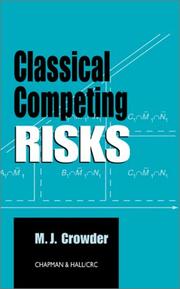
ISBN: 1584881755 9781584881759 Year: 2001 Publisher: Boca Raton, Fla Chapman & Hall/CRC
Abstract | Keywords | Export | Availability | Bookmark
 Loading...
Loading...Choose an application
- Reference Manager
- EndNote
- RefWorks (Direct export to RefWorks)
The last book dedicated to this topic was published in 1978, and since then there have been many developments in survival analysis, Competing Risks, and in statistical methods in general. The subject is now drawing increasing interest from engineers and biologists. Written by an acknowledged expert, this book thoroughly examines the probability framework and statistical analysis of data of Competing Risks. With a dearth of modern treatments of the subject and the importance of its methods, Classical Competing Risks fills a long-standing gap in the literature with a carefully organized exposition filled with real data sets, numerous examples, and clear, readable prose.
Mathematical statistics --- Competing risks --- Failure time data analysis --- Temps entre défaillances, Analyse des --- 519.2 --- Analysis, Failure time data --- Data analysis, Failure time --- Failure analysis (Engineering) --- Survival analysis (Biometry) --- Risks, Competing --- Distribution (Probability theory) --- Estimation theory --- Random variables --- Competing risks. --- Failure time data analysis. --- Temps entre défaillances, Analyse des
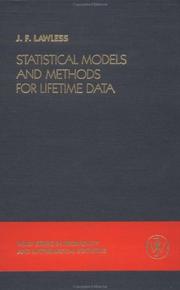
ISBN: 0471085448 9780471085447 Year: 1982 Publisher: New York Wiley
Abstract | Keywords | Export | Availability | Bookmark
 Loading...
Loading...Choose an application
- Reference Manager
- EndNote
- RefWorks (Direct export to RefWorks)
Mathematical statistics --- Failure time data analysis --- Reliability (Engineering) --- Temps entre défaillances, Analyse des --- Fiabilité --- Survival analysis (Biometry) --- Analysis, Survival (Biometry) --- Survivorship analysis (Biometry) --- Biometry --- Analysis, Failure time data --- Data analysis, Failure time --- Failure analysis (Engineering) --- Competing risks --- Failure time data analysis. --- Survival analysis (Biometry). --- Temps entre défaillances, Analyse des --- Fiabilité
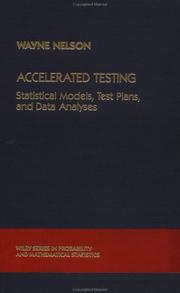
ISBN: 0471522775 Year: 1990 Publisher: New York Wiley
Abstract | Keywords | Export | Availability | Bookmark
 Loading...
Loading...Choose an application
- Reference Manager
- EndNote
- RefWorks (Direct export to RefWorks)
Mathematical statistics --- Accelerated life testing --- -Failure time data analysis --- Reliability (Engineering) --- -Mathematical statistics --- Analysis, Failure time data --- Data analysis, Failure time --- Failure analysis (Engineering) --- Competing risks --- Survival analysis (Biometry) --- Accelerated testing --- Life testing, Accelerated --- Reliability testing --- Testing --- Statistical methods --- Failure time data analysis. --- Statistical methods. --- -Statistical methods --- Failure time data analysis
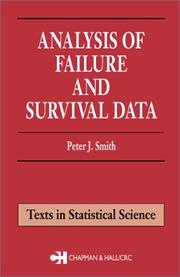
ISBN: 1584880759 Year: 2002 Publisher: Boca Raton, Fla Chapman & Hall/CRC
Abstract | Keywords | Export | Availability | Bookmark
 Loading...
Loading...Choose an application
- Reference Manager
- EndNote
- RefWorks (Direct export to RefWorks)
Failure time data analysis --- Regression analysis --- Survival analysis (Biometry) --- 519.23 --- 519.2 --- Analysis, Regression --- Linear regression --- Regression modeling --- Multivariate analysis --- Structural equation modeling --- Analysis, Failure time data --- Data analysis, Failure time --- Failure analysis (Engineering) --- Mathematical statistics --- Competing risks --- 519.2 Probability. Mathematical statistics --- Probability. Mathematical statistics --- 519.23 Statistical analysis. Inference methods --- Statistical analysis. Inference methods --- Analysis, Survival (Biometry) --- Survivorship analysis (Biometry) --- Biometry
Book
ISBN: 9781420073881 1420073885 9780429139604 Year: 2011 Publisher: Boca Raton, Fla CRC Press, Taylor & Francis Group
Abstract | Keywords | Export | Availability | Bookmark
 Loading...
Loading...Choose an application
- Reference Manager
- EndNote
- RefWorks (Direct export to RefWorks)
"The concept of frailty offers a convenient way to introduce unobserved heterogeneity and associations into models for survival data. In its simplest form, frailty is an unobserved random proportionality factor that modifies the hazard function of an individual or a group of related individuals. Frailty Models in Survival Analysis presents a comprehensive overview of the fundamental approaches in the area of frailty models. The book extensively explores how univariate frailty models can represent unobserved heterogeneity. It also emphasizes correlated frailty models as extensions of univariate and shared frailty models. The author analyzes similarities and differences between frailty and copula models; discusses problems related to frailty models, such as tests for homogeneity; and describes parametric and semiparametric models using both frequentist and Bayesian approaches. He also shows how to apply the models to real data using the statistical packages of R, SAS, and Stata. The appendix provides the technical mathematical results used throughout. Written in nontechnical terms accessible to nonspecialists, this book explains the basic ideas in frailty modeling and statistical techniques, with a focus on real-world data application and interpretation of the results. By applying several models to the same data, it allows for the comparison of their advantages and limitations under varying model assumptions. The book also employs simulations to analyze the finite sample size performance of the models."--Publisher's description.
Mathematical statistics --- Failure time data analysis --- Survival analysis (Biometry) --- Mortality --- Demography --- Mathematics --- Mathematical models --- #SBIB:314H160 --- #SBIB:303H520 --- #SBIB:314H220 --- Historical demography --- Social sciences --- Population --- Vital statistics --- Mortality, Law of --- Death --- Death (Biology) --- Analysis, Survival (Biometry) --- Survivorship analysis (Biometry) --- Biometry --- Analysis, Failure time data --- Data analysis, Failure time --- Failure analysis (Engineering) --- Competing risks --- Bevolkingsstudies: onderzoeks- en analysemethoden --- Methoden sociale wetenschappen: techniek van de analyse, algemeen --- Mortaliteit: algemeen --- Failure time data analysis - Mathematics --- Survival analysis (Biometry) - Mathematics --- Mortality - Mathematical models --- Demography - Mathematics
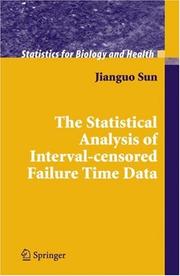
ISBN: 1280865865 9786610865864 0387371192 0387329056 1441921923 9780387329055 Year: 2006 Publisher: New York, N.Y. Springer
Abstract | Keywords | Export | Availability | Bookmark
 Loading...
Loading...Choose an application
- Reference Manager
- EndNote
- RefWorks (Direct export to RefWorks)
Survival analysis, the analysis of failure time data, is a rapid developing area and a number of books on the topic have been published in last twenty-five years. However, all of these books deal with right-censored failure time data, not the analysis of interval-censored failure time data. Interval-censored data include right-censored data as a special case and occur in many fields. The analysis of interval-censored data is much more difficult than that of right-censored data because the censoring mechanism that yields interval censoring is more complicated than that for right censoring. This book collects and unifies statistical models and methods that have been proposed for analyzing interval-censored failure time data. It provides the first comprehensive coverage of the topic of interval-censored data and complements the books on right-censored data. A number of inference approaches are discussed in the book, including the maximum likelihood, estimating equations, sieve maximum likelihood, and conditional likelihood. One major difference between the analyses of right- and interval-censored data is that the theory of counting processes, which is responsible for substantial advances in the theory and development of modern statistical methods for right-censored data, is not applicable to interval-censored data. The focus of the book is on nonparametric and semiparametric inferences, but it also describes parametric and imputation approaches. In addition, Bayesian methods and the analysis of interval-censored data with informative interval censoring are considered as well as the analysis of interval-censored recurrent event, or panel count, data. This book provides an up-to-date reference for people who are conducting research on the analysis of interval-censored failure time data as well as for those who need to analyze interval-censored data to answer substantive questions. It can also be used as a text for a graduate course in statistics or biostatistics that assume a basic knowledge of probability and statistics. Jianguo (Tony) Sun is a professor at the Department of Statistics of the University of Missouri-Columbia. He has developed novel statistical methods for the analysis of interval-censored failure time data and panel count data over the last fifteen years.
Failure time data analysis. --- Analysis, Failure time data --- Data analysis, Failure time --- Failure analysis (Engineering) --- Mathematical statistics --- Competing risks --- Survival analysis (Biometry) --- Distribution (Probability theory. --- Statistics. --- Probability Theory and Stochastic Processes. --- Statistics for Life Sciences, Medicine, Health Sciences. --- Statistical analysis --- Statistical data --- Statistical methods --- Statistical science --- Mathematics --- Econometrics --- Distribution functions --- Frequency distribution --- Characteristic functions --- Probabilities --- Probabilities. --- Statistics . --- Probability --- Statistical inference --- Combinations --- Chance --- Least squares --- Risk
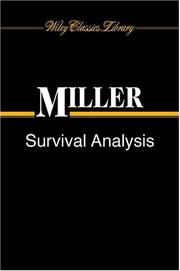
ISBN: 0471255483 047109434X 9780471255482 Year: 1981 Publisher: New York (N.Y.) Wiley
Abstract | Keywords | Export | Availability | Bookmark
 Loading...
Loading...Choose an application
- Reference Manager
- EndNote
- RefWorks (Direct export to RefWorks)
Failure time data analysis --- Survival analysis (Biometry) --- Failure time data analysis. --- Survival analysis (Biometry). --- regressie-analyse --- wiskundige statistiek --- 519.22 --- Analysis, Survival (Biometry) --- Survivorship analysis (Biometry) --- Biometry --- Analysis, Failure time data --- Data analysis, Failure time --- Failure analysis (Engineering) --- Mathematical statistics --- Competing risks --- 519.22 Statistical theory. Statistical models. Mathematical statistics in general --- Statistical theory. Statistical models. Mathematical statistics in general --- Temps entre défaillances, Analyse des
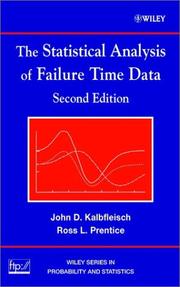
ISBN: 047136357X 9780471363576 Year: 2002 Publisher: Hoboken, N.J. Wiley
Abstract | Keywords | Export | Availability | Bookmark
 Loading...
Loading...Choose an application
- Reference Manager
- EndNote
- RefWorks (Direct export to RefWorks)
* Contains additional discussion and examples on left truncation as well as material on more general censoring and truncation patterns. * Introduces the martingale and counting process formulation swil lbe in a new chapter. * Develops multivariate failure time data in a separate chapter and extends the material on Markov and semi Markov formulations. * Presents new examples and applications of data analysis.
Mathematical statistics --- QA 276 .K215 Mathematical statistics --- Failure time data analysis --- Survival analysis (Biometry) --- Regression analysis --- AA / International- internationaal --- 303.0 --- 304.0 --- 519.5 --- Analysis, Regression --- Linear regression --- Regression modeling --- Multivariate analysis --- Structural equation modeling --- Analysis, Survival (Biometry) --- Survivorship analysis (Biometry) --- Biometry --- Analysis, Failure time data --- Data analysis, Failure time --- Failure analysis (Engineering) --- Competing risks --- Statistische technieken in econometrie. Wiskundige statistiek (algemene werken en handboeken). --- Zuivere statistische analyse (algemene naslagwerken). Tijdreeksen. --- Failure time data analysis. --- Regression analysis. --- Survival analysis (Biometry). --- Statistische technieken in econometrie. Wiskundige statistiek (algemene werken en handboeken) --- Zuivere statistische analyse (algemene naslagwerken). Tijdreeksen
| Listing 1 - 10 of 15 | << page >> |
Sort by
|

 Search
Search Feedback
Feedback About UniCat
About UniCat  Help
Help News
News